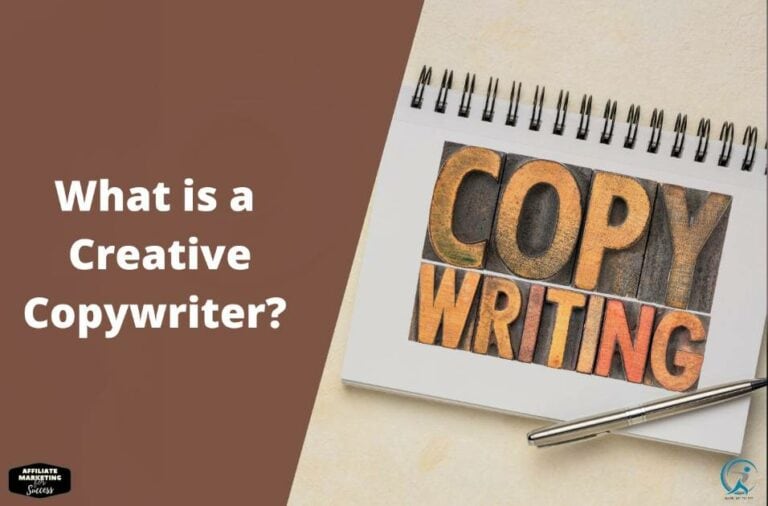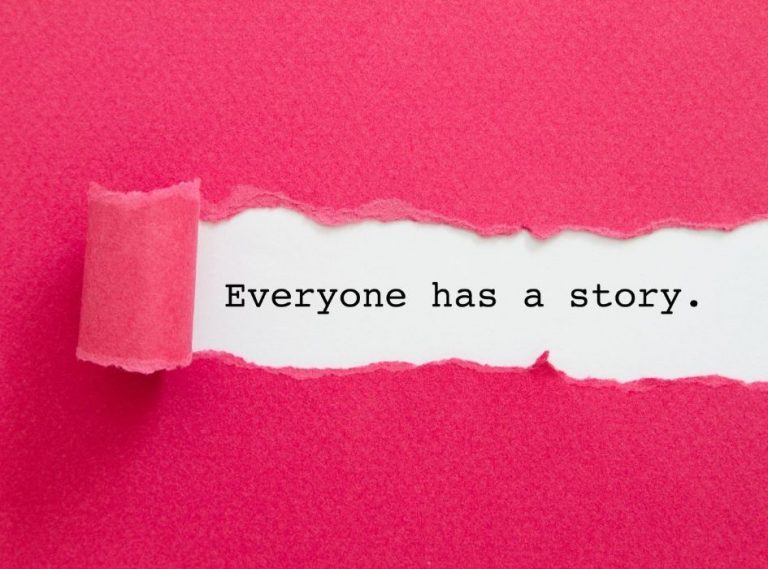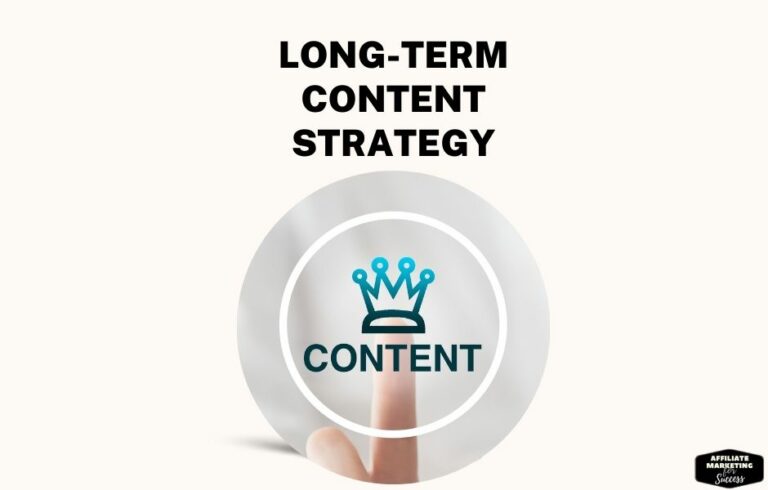How to Create Evergreen Content That Ranks [2025 Guide]
Ever feel like your content gets lost in the noise shortly after you hit publish? You’re not alone. In today’s fast-paced digital world, creating content that stands the test of time is more crucial than ever.
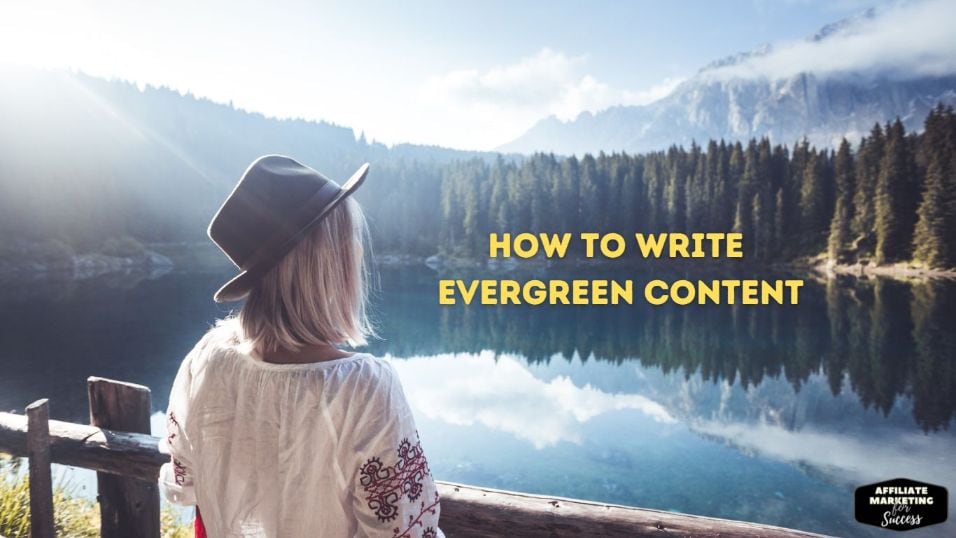
Evergreen Content Creation: Timeless Strategies That Work
Plant Once, Harvest Forever: Master Evergreen Content
Evergreen content is your ticket to sustained traffic, engagement, and authority in your niche.
Key Takeaways
- Evergreen content remains relevant and valuable over a long period.
- It helps in attracting consistent organic traffic.
- Brainstorm topics that address ongoing needs and interests.
- Optimize your content for search engines to enhance visibility.
- Regularly update your evergreen pieces to maintain their relevance.
- Incorporate multimedia elements like images and tables for better engagement.
What is Evergreen Content?
Evergreen content refers to articles, blog posts, or media that remain relevant and valuable to readers over a long period—much like evergreen trees that retain their leaves all year round.
Characteristics of Evergreen Content
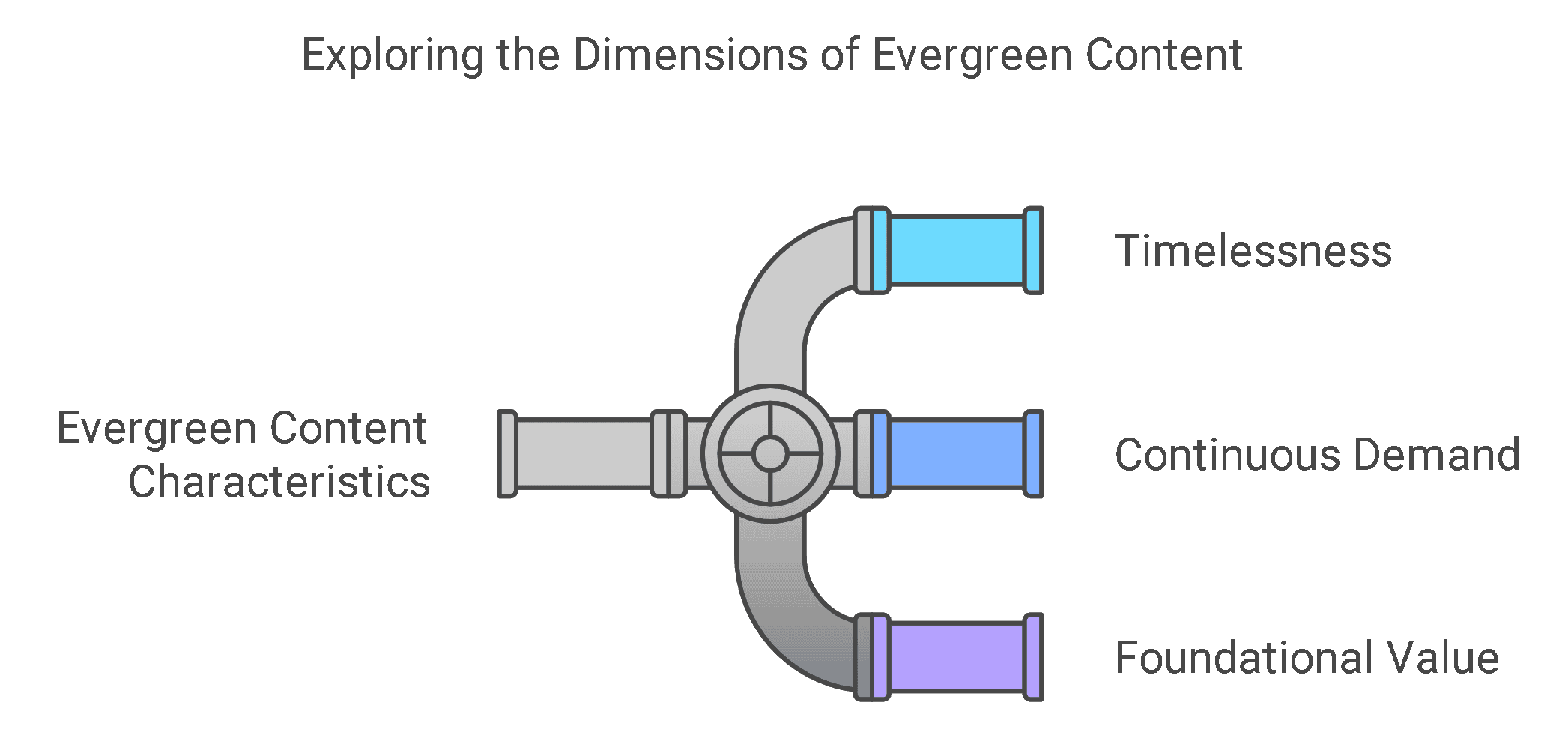
- Timelessness: It doesn’t rely on current trends or news.
- Continuous Demand: Addresses topics that people consistently search for.
- Foundational Value: Provides fundamental information or insights.
Related Article: Learn more about the benefits of blogging for your business.
Why Evergreen Content Matters
Creating evergreen content is a strategic investment in your website’s future.
| Benefit | Description |
|---|---|
| Consistent Traffic | Attracts visitors over time without additional promotion efforts. |
| SEO Advantages | Ranks well in search engines due to sustained relevance. |
| Authority Building | Establishes you as a knowledgeable resource in your niche. |
| Better ROI | Yields long-term returns compared to time-sensitive content. |
Brainstorming Evergreen Content Ideas
To generate ideas that stand the test of time, focus on foundational topics in your niche.
Strategies for Idea Generation
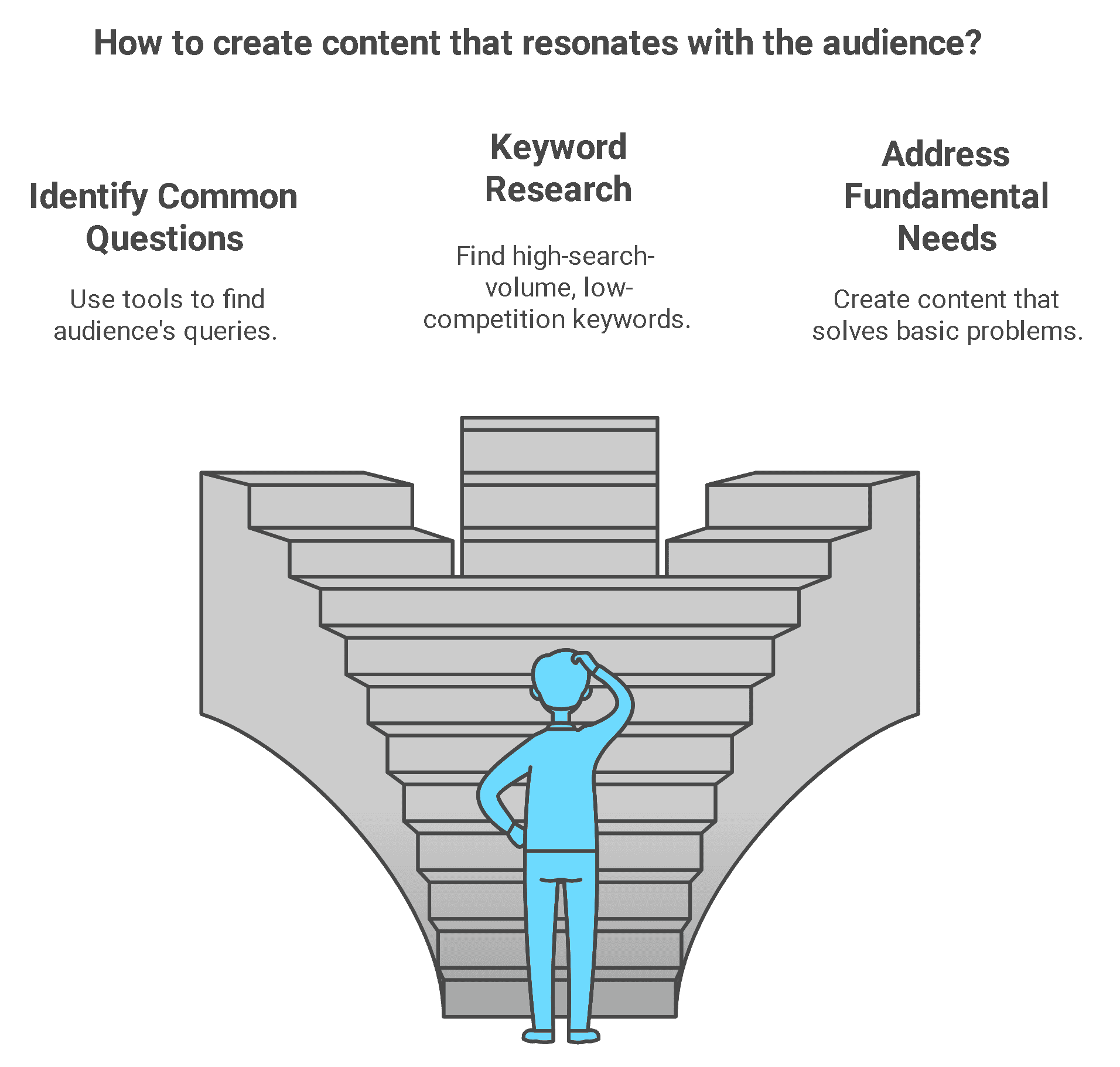
- Identify Common Questions: Use tools like AnswerThePublic to find what your audience is asking.
- Keyword Research: Identify high-search-volume keywords with low competition.
- Address Fundamental Needs: Create content that solves basic problems or explains core concepts.
Tip: Check out our guide on keyword stemming to optimize your keyword strategy.
Writing High-Quality Evergreen Articles
Quality is paramount for evergreen content. Here’s how to ensure your articles meet the mark.
Tips for Writing
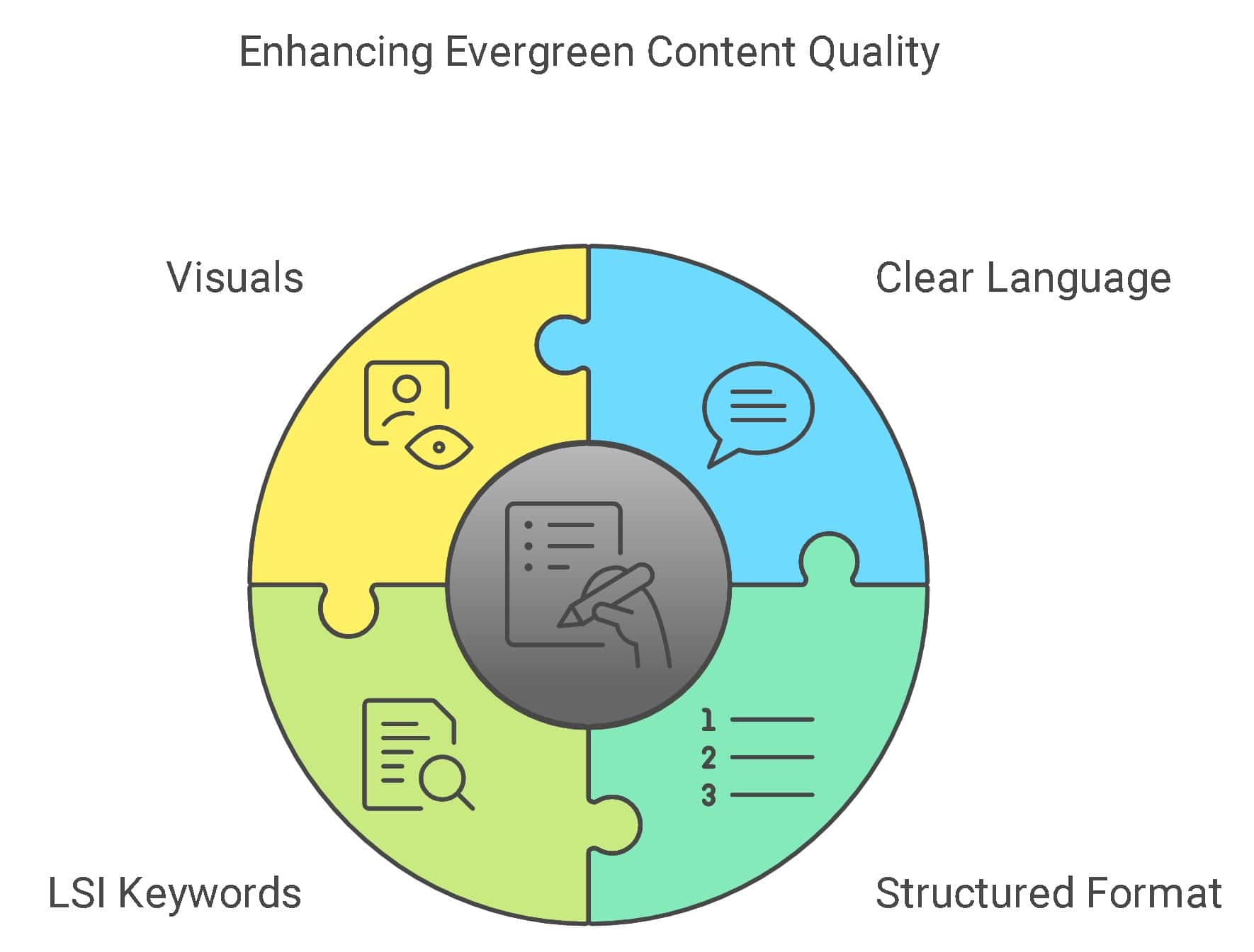
- Use Clear Language: Write in an easy-to-understand, conversational tone.
- Structure Well: Utilize headings, bullet points, and tables for readability.
- Incorporate LSI Keywords and Entities: Enhance SEO by naturally including related terms.
- Add Visuals: Use images to break up text and aid understanding.
Related Guide: Improve your writing with our SEO writing tips.
Optimizing for Search Engines
SEO optimization ensures your evergreen content is discoverable.
SEO Best Practices
| Aspect | Action |
|---|---|
| Keyword Optimization | Include primary and secondary keywords naturally throughout the content. |
| Meta Descriptions | Write compelling meta descriptions to improve click-through rates. |
| Internal Linking | Link to other relevant pages on your site to boost SEO. |
| Mobile-Friendly Design | Ensure your content is accessible on all devices. |
Further Reading: Master SEO with our article on boosting organic ranking.
Proven Evergreen Content Formats
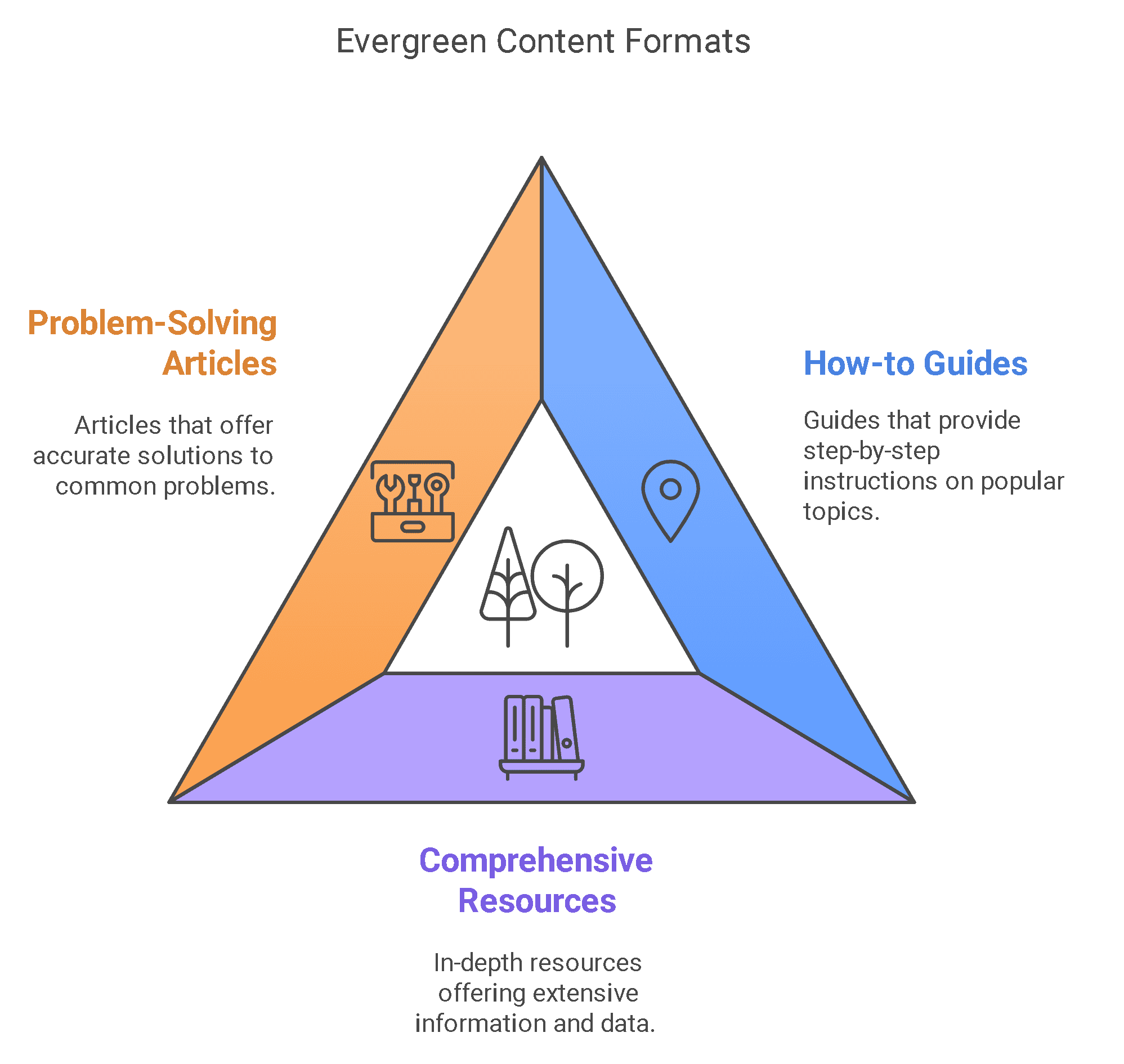
- How-to Guides
- Example: “How to Start a Podcast” by Pat Flynn generates 100K+ monthly visits
- Reason for success: Detailed steps, regular tech updates
- Comprehensive Resources
- Example: Backlinko’s “SEO Guide” attracts 350K+ monthly readers
- Success factor: In-depth information, data-backed strategies
- Problem-Solving Articles
- Example: Healthline’s “How to Lower Blood Pressure” gets 500K+ monthly views
- Key element: Medical accuracy, practical solutions
Best Practices for 2025
1. Data-Driven Foundation
- Include current statistics
- Link to authoritative sources
- Update data points annually
Example: Hubspot's "Marketing Statistics" page
Updated quarterly
500K+ monthly visitors
90% organic traffic
2. Search Intent Optimization
- Target questions people consistently ask
- Address multiple related queries
- Use tools like:
- Google’s “People Also Ask”
- AnswerThePublic
- BuzzSumo
3. Content Structure
- Clear headings
- Scannable paragraphs
- Bullet points
- Visual elements
- Action steps
4. Technical Optimization
- Mobile-first design
- Fast loading speed (<3 seconds)
- Schema markup
- Internal linking strategy
Real-Life Success Stories of Successful Evergreen Content
Case Study 1: Wirecutter
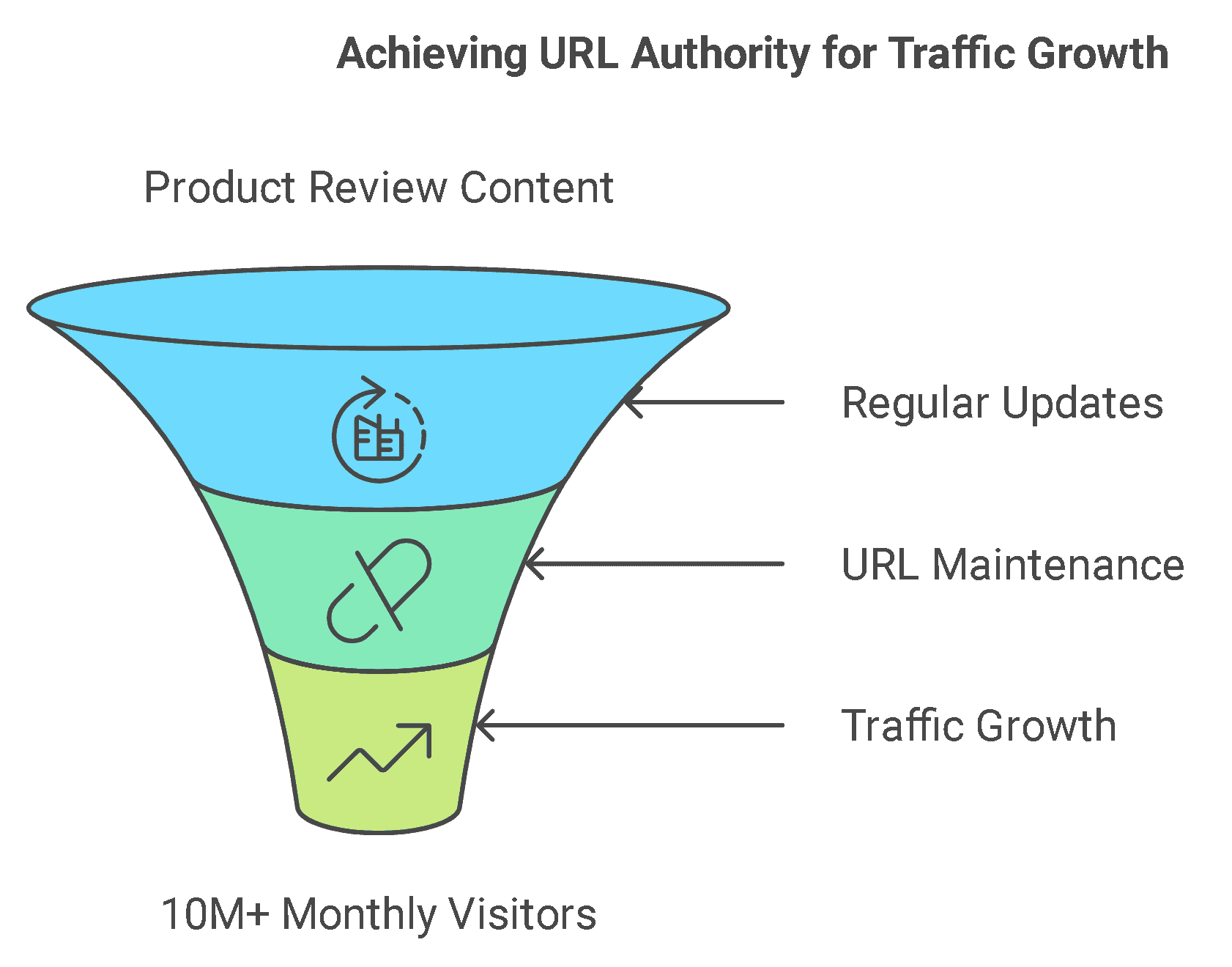
- Content type: Product reviews
- Strategy: Regular updates to same URLs
- Result: 10M+ monthly visitors
- Key learning: Maintain URL authority
Case Study 2: Khan Academy
- Content type: Educational guides
- Strategy: Foundational concepts
- Result: 18M+ monthly users
- Key learning: Focus on timeless topics
Implementation Tips
- Content Calendar
- 70% evergreen
- 30% trending topics
- Update Schedule
- Quarterly content audits
- Annual major updates
- Monthly fact-checking
- Quality Markers
- Expert quotes
- Original research
- Real user examples
Common Mistakes to Avoid
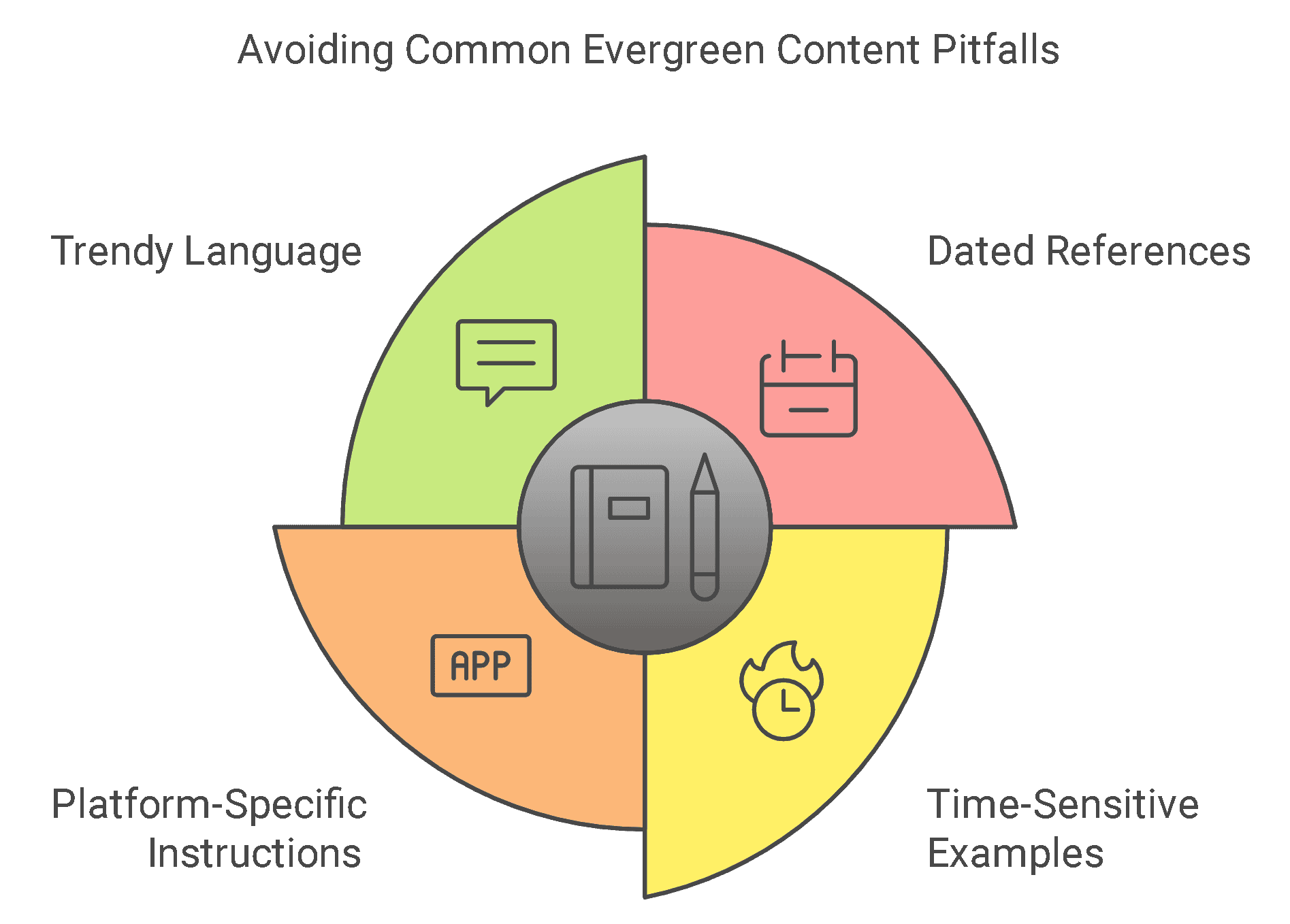
❌ Dated references
❌ Time-sensitive examples
❌ Platform-specific instructions
❌ Trendy language
Measuring Success
Key Metrics:
- Time on page
- Bounce rate
- Return visitors
- Social shares
- Backlink growth
Regularly Updating Your Content
Even evergreen content benefits from occasional updates.
Why Update?
- Refreshes SEO Value: Search engines favor updated content.
- Maintains Accuracy: Keeps information current and correct.
- Enhances User Experience: Provides the most valuable content to your readers.
Check This Out: Learn how to update old blog content effectively.
Internal Linking Strategies
Strategically placing internal links enhances navigation and SEO.
How to Implement

- Contextual Links: Embed links naturally within the content where relevant.
- Diverse Anchor Texts: Use varied and descriptive anchor texts.
- Even Distribution: Spread links evenly to maintain a natural flow.
Recommended Reading: Understand the importance of internal linking for SEO.
Useful Resources
- Affiliate Marketing Tools
Enhance your marketing efforts with these essential tools. - SEO Keyword Research Tool
Discover the best keywords for your content. - Content Idea Generator
Kickstart your brainstorming process. - Boost Your Organic Ranking
Advanced strategies to climb SERP rankings. - Monetize Your Blog
Learn effective ways to generate income from your blog. - Email Marketing Benefits
Why email marketing remains a powerful tool.
By implementing these strategies, you’ll create evergreen content that continues to attract and engage readers for years to come.
Unable to render image
Alt text: Upward trending graph indicating sustained content success over time.
Image Prompt: “A thriving evergreen tree with deep roots and lush foliage, symbolizing enduring content.”
Conclusion
Evergreen content is a cornerstone of a successful long-term content strategy. By focusing on timeless topics, optimizing for SEO, and regularly updating your articles, you’ll reap the benefits of sustained traffic and authority in your niche.
Ready to take your content to the next level? Start implementing these evergreen strategies today and watch your traffic grow over time!
Next Steps:
- Begin brainstorming evergreen topics relevant to your audience.
- Audit your existing content for evergreen potential.
- Plan a schedule for regular content updates.
References
The Beginner’s Guide to Evergreen Content – Digital Marketing Institute
Creating evergreen content should be an ongoing goal for your business, so it’s likely you’ll use most of the formats at some time. 1. Original Research 2. Successful Case Studies …
How to Create Evergreen Content Right From the Start – Neil Patel
7 Tips for Creating Evergreen Content Right From the Start To be clear, not all your content needs to be evergreen. Your audience wants to know you’ve got your finger …
How to Create Evergreen Content That Generates Traffic to Your Site
Now that we’ve established how critical evergreen content is for your digital marketing strategy, it’s time to learn the ropes of creating one that can be impactful for years. Follow …
What Evergreen Content Is and How to Create it – Business News Daily
Evergreen content is an important part of any content marketing strategy. Here’s how to create it. Evergreen content is relevant for a long time and provides value to your audience …
How to Create Evergreen Content (And Keep It That Way)
Next, we’ll go into the steps of developing evergreen content and how to ensure it stays this way. 1. Make a Top 50 List of Questions and Ideas What are …
Your Guide To Creating Evergreen Content – Forbes
2. Check Google Trends. If you’re undecided about whether a topic is evergreen, search Google Trends for the keyword. If the “Interest over time” chart is a downward slope or …
How To Create and Maintain Evergreen Content – SocialPilot
How To Create Your Own Evergreen Content The real-easy step here and the most apparent recommendation, at first sight, is to understand carefully; Google is aiming at users, not marketers. …
How To Create Evergreen Content: Step-By-Step Guide
How to create evergreen content: 5 essential steps To simplify the whole process, we’ve broken it down into a framework consisting of 5 major steps.
I’m Alexios Papaioannou, an experienced affiliate marketer and content creator. With a decade of expertise, I excel in crafting engaging blog posts to boost your brand. My love for running fuels my creativity. Let’s create exceptional content together!



